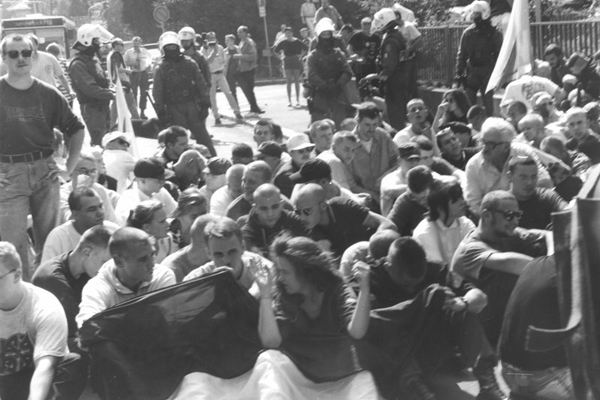Did German Intelligence Fuel Far-Right Extremism?
Source: spiegel.de

A secret paper written by senior police officers paints a disastrous picture of Germany’s domestic intelligence agency. It suggests that the service may have actually strengthened the country’s far-right scene through its large network of far-right informants.
It’s a Wednesday in early summer 2012, on the terrace of a Chinese restaurant in Nuremberg’s city center. Kai D., 48, once one of the most subversive activists in the German neo-Nazi community, is sitting at a table, drinking a glass of roasted wheat tea, the house specialty, eagerly answering questions about his past in the right-wing extremist community.
The ex-Nazi seems at ease as he chats about his experiences as the head of the Covenant of the New Front (Gesinnungsgemeinschaft der Neuen Front) and the Thule Network, a neo-Nazi data-sharing group, which he helped build. He describes his role as one of the organizers of the Rudolf Hess memorial marches -- annual neo-Nazi ceremonies in memory of the prominent Nazi politician that were banned by German courts in 2005. He talks about the tiresome pressure from the police with all the interrogations and raids. He also admits to having known members of a group called the Thüringer Heimatschutz (loosely translated as "Thuringian Homeland Protection"), where the terrorists who later formed the National Socialist Underground (NSU) became radicalized. According to D., they were the people who organized regular meetings in the eastern state of Thuringia. The authorities found D.’s number on a phone list used by NSU terrorist Uwe Mundlos.
On one subject, however, D. becomes tight-lipped. No, he says vehemently, "at no time, not even remotely" was he an informant for the Federal Office for the Protection of the Constitution (BfV), Germany’s domestic intelligence agency, and anyone who claims otherwise is lying.
Apparently, D. is still stretching the truth today. Responding to research conducted by SPIEGEL reporters, Bavarian Interior Minister Joachim Herrmann, a member of the conservative Christian Social Union (CSU), has told members of the Bavarian state parliament that D. worked with the Bavarian state intelligence service between the end of 1987 and 1998. D. was a major informant, and he was also one of the masterminds in the neo-Nazi network.
German law enforcement authorities uncovered the NSU right-wing terrorist cell almost exactly a year ago. On Nov. 4, 2011, the police found the bodies of Uwe Mundlos and Uwe Böhnhardt in a camper parked in the eastern city of Eisenach. The NSU claimed responsibility for killing at least nine men and a policewoman during a seven-year murder spree that began in 2000. The male victims, all of them shopkeepers or employeed in small businesses, belonged to ethnic minorities -- eight were of Turkish origin and one was Greek.
Systematic Failure
Four parliamentary committees of inquiry are currently dissecting the work of law enforcement units, and four department heads have already resigned. The government’s failures in fighting right-wing terrorists have plunged the domestic intelligence service into the worst crisis since it was established. It was set up in postwar Germany to identify and stop the spread of precisely the kind of extremist thinking that allowed the Nazis to rise to power in the 1930s. The discovery of the NSU and its crimes, however, has shaken the system to its core.
The committees are currently examining more than 100,000 pages of classified documents. The more secrets come to light, the clearer it becomes how extensively intelligence agencies had infiltrated right-wing extremist groups. The trio of neo-Nazis that made up the NSU was surrounded by informants linked with the Office for the Protection of the Constitution, and Kai D. was only one of many. Nevertheless, the authorities had no idea what plans were being hatched in the neo-Nazi underground. The system of undercover informants had failed.
One of the big questions now being asked is whether the Office for the Protection of the Constitution and its methods are suited to protecting the German constitution -- or whether it actually strengthened militant right-wing groups. "It cannot be that informants are being used who are more harmful to the community than they are beneficial," says Thomas Oppermann, a senior lawmaker for the opposition Social Democratic Party.
Once before, during the failed effort to ban the far-right NPD party in 2003, the links between law enforcement and right-wing extremist groups led to a political fiasco. The Federal Constitutional Court rejected the motion to ban the NPD because it appeared as if the government could in fact be controlling the right-wing extremists through its informants.
Incendiary Agents
The discussion is now being fueled by a previously unknown position paper dating from 1997. It comes from an authoritative source: the Federal Criminal Police Office (BKA), Germany’s version of the FBI. At the time, the police officials leveled serious charges against their counterparts with the German intelligence agencies, just a year before the NSU terrorists, who had operated in the eastern city of Jena, went into hiding. In the position paper that has now surfaced, which is still classified as "secret," the BKA listed 10 theories that were presented to the Office for the Protection of the Constitution.
The BKA document centers around the core idea that the informants egged each other on, essentially acting as incendiary agents. Instead of decisively combatting the neo-Nazis, the BKA posits, the intelligence agency protected them, and judging by the way the Office for the Protection of the Constitution deployed its informants, they became part of the problem and not part of the solution.
The classified document, which SPIEGEL has obtained, is both an urgent warning and an indictment of the agents at the Office for the Protection of the Constitution. Did the intelligence service, intoxicated by the exclusive access it had gained, in fact protect some members of the far right? Is it indirectly responsible for the strengthening of militant neo-Nazi structures in the 1990s, from which the NSU, the most brutal and militant of all the extremist groups, emerged?
The BKA paper was written at a time, just after German reunification, when right-wing extremist groups were bursting with strength. Attacks against foreigners in the eastern cities of Hoyerswerda and Rostock in 1991 and 1992 respectively were followed by deadly arson attacks against Turkish inhabitants in Mölln, a town near Hamburg, and in Solingen in the west. Hundreds of neo-Nazi skinheads staged rallies every August to mark the anniversary of the death of Hitler’s deputy, Rudolf Hess. Entire sections of eastern Germany became practically off-limits for foreigners. Mundlos, Böhnhardt and Beate Zschäpe -- the third member of the NSU group who is being held in police custody as she awaits trial -- grew up in a self-confident political movement that was enjoying unchecked growth.
[...]
Read the full article at: spiegel.de
Tune into Red Ice Radio:
Peter Dale Scott - Hour 1 - Norway’s Massacre, Breivik & Deep Events
Peter Dale Scott - Hour 2 - Systemic Destabilization & Global Shadow Elites
Rauni-Leena Luukanen-Kilde - The Norway Massacre, Anders Behring Breivik & Mind Control
Holland Vandennieuwenhof - Hour 2 - False Flag Methodology






















